Chapter 11: Exchange Rates and Payments with the Rest of the World
1/28
There's no tags or description
Looks like no tags are added yet.
Name | Mastery | Learn | Test | Matching | Spaced |
|---|
No study sessions yet.
29 Terms
Exchange Rate
Price one currency exchanges for another currency
Ex. if C$1.00 = US$0.90; it takes 90 cents US to buy 1 Canadian dollar
Foreign Exchange Market
Worldwide market where currencies bought and sold
The only people who are going to the foreign exchange market are those interested/needing another currency
Currency Depreciation vs. Appreciation
Currency Depreciation: fall in exchange rate of one currency for another
Ex. Before: $1 USD = ¥150 — After: $1 USD = ¥130
$1 USD buys less Euros
Currency Appreciation: rise in exchange rate of one currency for another
Ex. Before: $1 USD = €0.90 — After: $1 USD = €1.00
$1 USD buys more Euros
Law of Demand for Canadian Dollars
As exchange rate rises, quantity demanded of C$ decreases (inverse relationship)
With higher value of C$:
R.O.W. buys less
Quantity demanded for C$ decreases
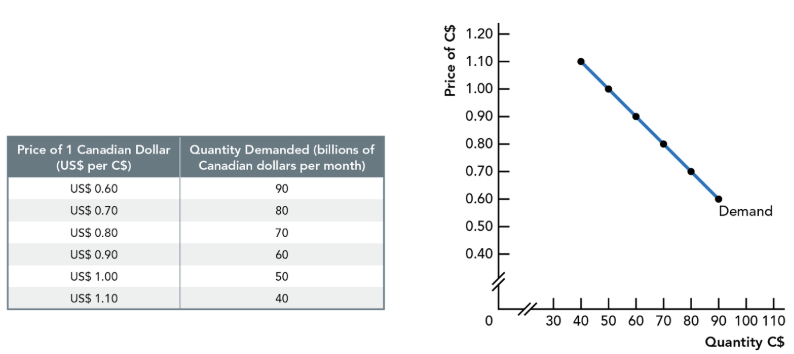
Law of Supply for Canadian Dollars
As exchange rate rises, quantity supplied of C$ increases (direct relationship)
With higher value of C$:
R.O.W imports and assets less expensive for Canadians, so Canadians buy more of them
To buy more R.O.W imports and assets, Canadians demand more foreign currency, so quantity supplied of C$ increases
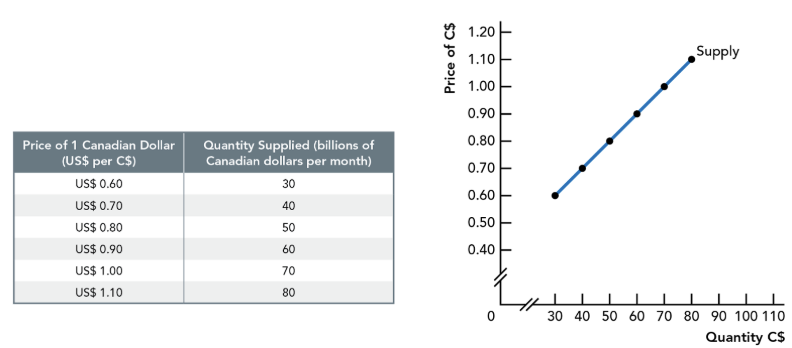
Foreign Exchange Market for Canadian Dollars
At equilibrium exchange rate: quantity demanded = quantity supplied of C$
Below equilibrium exchange rate: quantity demanded > quantity supplied — excess demand (shortages) for C$, buyers competition causes exchange rate to rise
Above equilibrium exchange rate: quantity demanded < quantity supplied — excess supply (surpluses) for C$, buyers competition causes exchange rate to fall
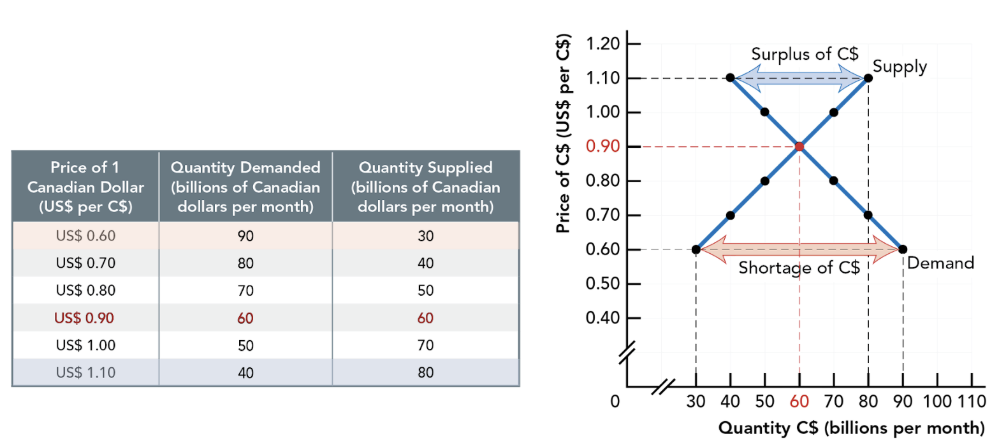
Supply of one currency is demand for another currency
Americans demanding C$ supply US$ in exchange
Canadians demanding US$ supply C$ in exchange
Reciprocal Exchange Rate
Divide 1 by the other exchange rate
Ex. if C$1.00 = US$0.90, reciprocal exchange rate is US$1.00 = 1/0.90 = C$1.11
It takes C$1.11 to buy US $1.00
When C$ appreciates against any currency, the currency depreciates against C$, and vice-versa

Interest Rate Differential
Difference in interest rates between countries
Increase in Canadian interest rate differential causes C$ to appreciate (increases demand and decreases supply of C$)
Decrease in Canadian interest has opposite effect
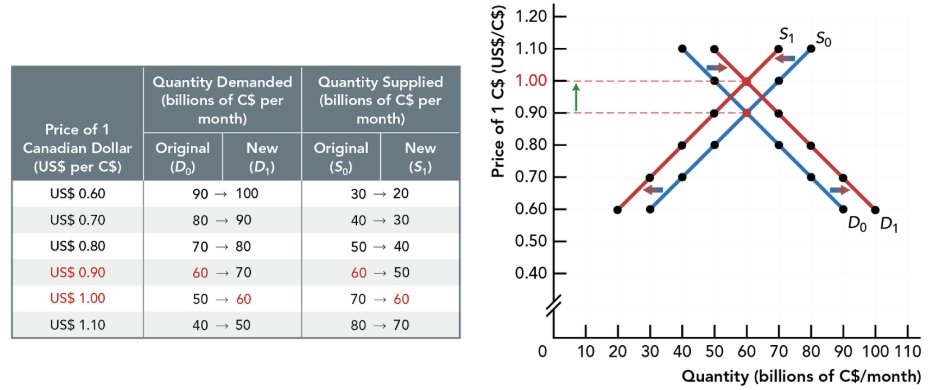
Inflation Rate Differential
Difference in inflation rates between countries
Increase in Canadian inflation rate differential causes C$ to depreciate (decreases demand and supply of C$)
Decrease in Canadian interest has opposite effect
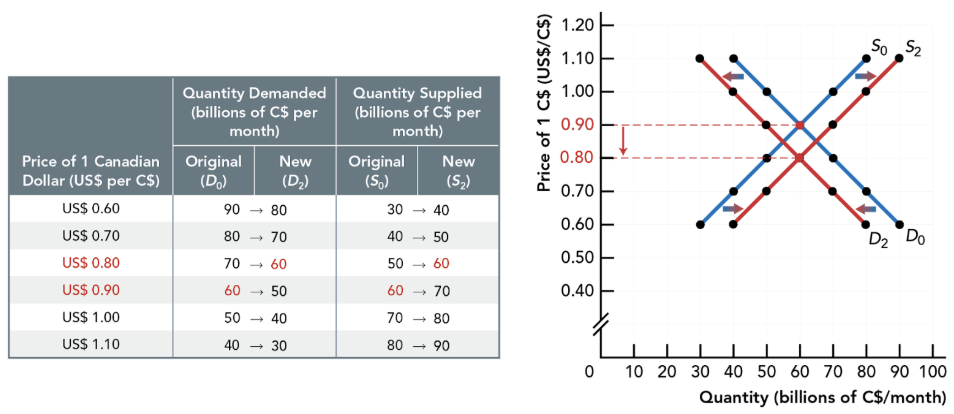
Effects of increasing real GDP on C$
Increased investor confidence causes strong appreciation
Net effect is C$ appreciates
Solo changes in demand fir C$
Increasing R.O.W demand for Canadian exports causes slight appreciation of C$ (increases demand for C$)
Rising world prices for Canadian resource exports causes C$ to appreciate relative to currencies of non-resource producing countries (increases demand for C$)
Currency speculators are the most important force for…
Fluctuations of foreign exchange rates
Daily value world goods trade 2022 = US$68 billion
Daily value foreign currency exchange 2022 = US$8 trillion
Expected rise in future price of the C$ causes appreciation of C$ (increases demand for C$)
Speculators reinforce and speed up effects of other forces on the price of C$
Forces Changing the Price of the Canadian Dollar
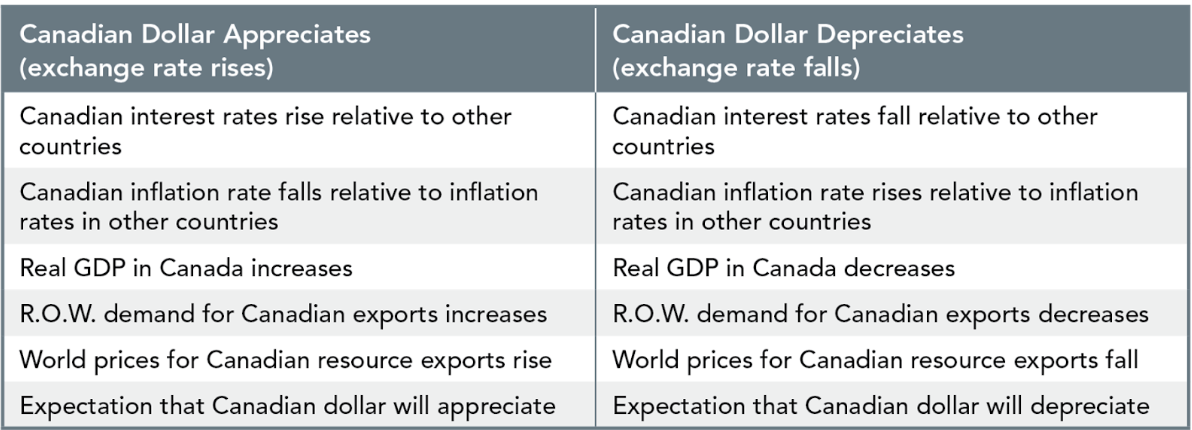
International Transmission Mechanism
How exchange rate affect real GDP and inflation
Appreciating C$
Negative aggregate demand shock
Decreases net exports
Decreasing aggregate demand
Decreasing real GDP
Increasing unemployment
Causes disinflation
Pushes economy into a contractions
Puts downward pressure on the Canadian price level
Depreciating C$
Positive aggregate demand shock
Increases net exports
Increasing aggregate demand
Increasing real GDP
Decreasing unemployment
Increases inflation
Pushes the economy into an expansion
Puts upward pressure on the Canadian price level
Advantages and disadvantages to both higher and lower exchange rates
Appreciating C$
Makes imports less expensive
But a negative demand shock
Hurts exporters/exports decrease
Decrease real GDP
Increasing unemployment
Decreasing inflation
Depreciating C$
Makes imports more expensive
But a positive demand shock
Helps exporters/exports increase
Increasing real GDP
Decreasing unemployment
Increasing inflation
Law of One Price
Predictions where exchange rates settle
Profit seekers eliminate differences across markets in prices of same product
This is arbitrage — buying and selling of products (or funds) to profit from a difference in price
Purchasing Power Parity (PPP)
Exchange rates adjust so that money has equal purchasing power in any country
Does not account for trading limitations
Is the best available standard for judging exchange rates
Does not account for the role of speculators in influencing exchange rates
Ex. C$15 buys exactly the same products in Canada, and when converted into US$ at PP exchange rate, and in the United States
If purchasing power parity does NOT hold, for example, Canadian $ more valuable than US $ for some purchases
People sell C$ for US$ —> increase supply Canadian $
Canadian $ depreciates
When PP does not exist, profit-seeking forces and law of one price push exchange rate toward PPP rate
PPP does not account for trading limitations and role of speculators influencing exchange rates
Rate of Return Parity (Interest Rate Parity)
Rates of return on investments are equal across countries, accounting for expected depreciation or appreciation of exchange rates
Ex. Rate of Return in Japan = Rate of Return in Canada - Expected depreciation or appreciation of yen against C$
Floating Exchange Rate vs Fired Exchange Rate
Floating Exchange Rate: determined by demand and supply in foreign exchange market
Fixed Exchange Rate: determined by governments or central banks
Balance of Payments Accounts
Measure a country’s international transactions
Current account
Financial (capital account)
Statistical discrepancy
Flow of C$
On Balance of payments accounts
Into Canada are positive numbers
Out of Canada are negative numbers
Current Account
Measures flows of exports, imports (and net investment/labour/transfer income
Canadian exports create a positive inflow of C$
Imports create a negative outflow of C$
Deficit/negative balance when Canadian spending on imports fromR.O.W. > R.O.W. spending on Canadian exports
Surplus/positive balance when R.O.W. spending on Canadian exports > Canadian spending on imports from R.O.W.
Financial Account (Capital Account)
Measures international investments in financial assets like bonds and direct investment in buying business
Canadian investments in R.O.W. are negative outflows of C$
R.O.W. investments in Canada are positive inflow of C$
Deficit/negative balance when Canadian investments in R.O.W > R.O.W investments in Canada
Surplus/positive balance when R.O.W. investments in Canada > Canadian investments in R.O.W
Statistical Discrepancy
For missing data and errors; is not important for balance of payments
The balance of payments accounts must sum to zero (current account balance + financial account balance + statistical discrepancy = 0)
In the absence of statistical discrepancy, when there is a current account surplus, there is a financial account deficit, and vice-versa
When there is a current account surplus…
There is a financial account deficit
If R.O.W spends more on Canadian exports than Canadians spend on R.O.W imports, where does R.O.W. get extra C$?
From financial account deficit, with Canadians “loaning” R.O.W. extra C$ through investments
When there is current account deficit…
There is a financial account surplus
If Canada spends more on R.O.W. imports than R.O.W. spends on Canadian exports, where does Canada get extra foreign currency?